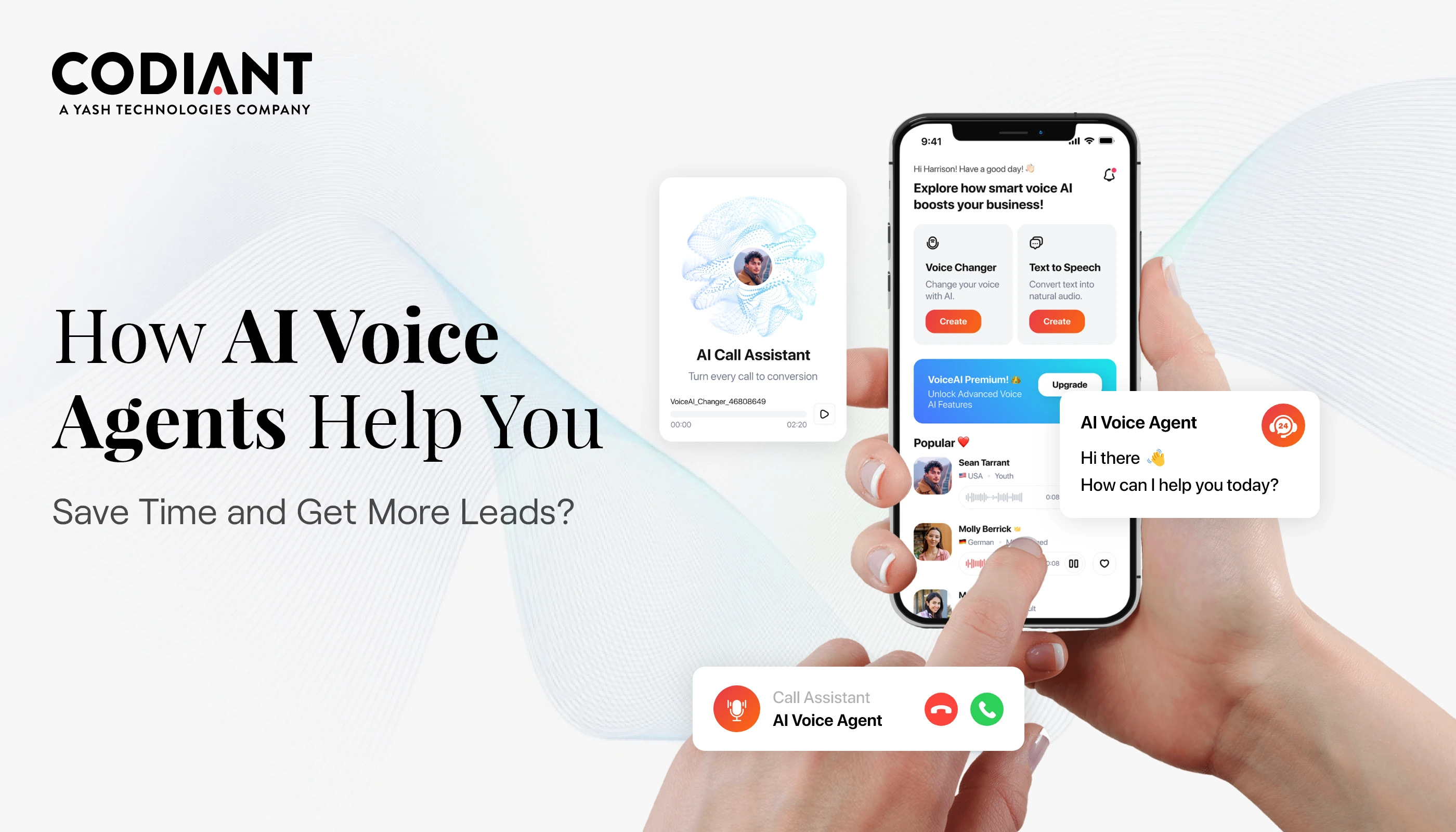Cost To Develop A Digital Transformation Strategy For US Businesses
Table of Contents
Subscribe To Our Newsletter
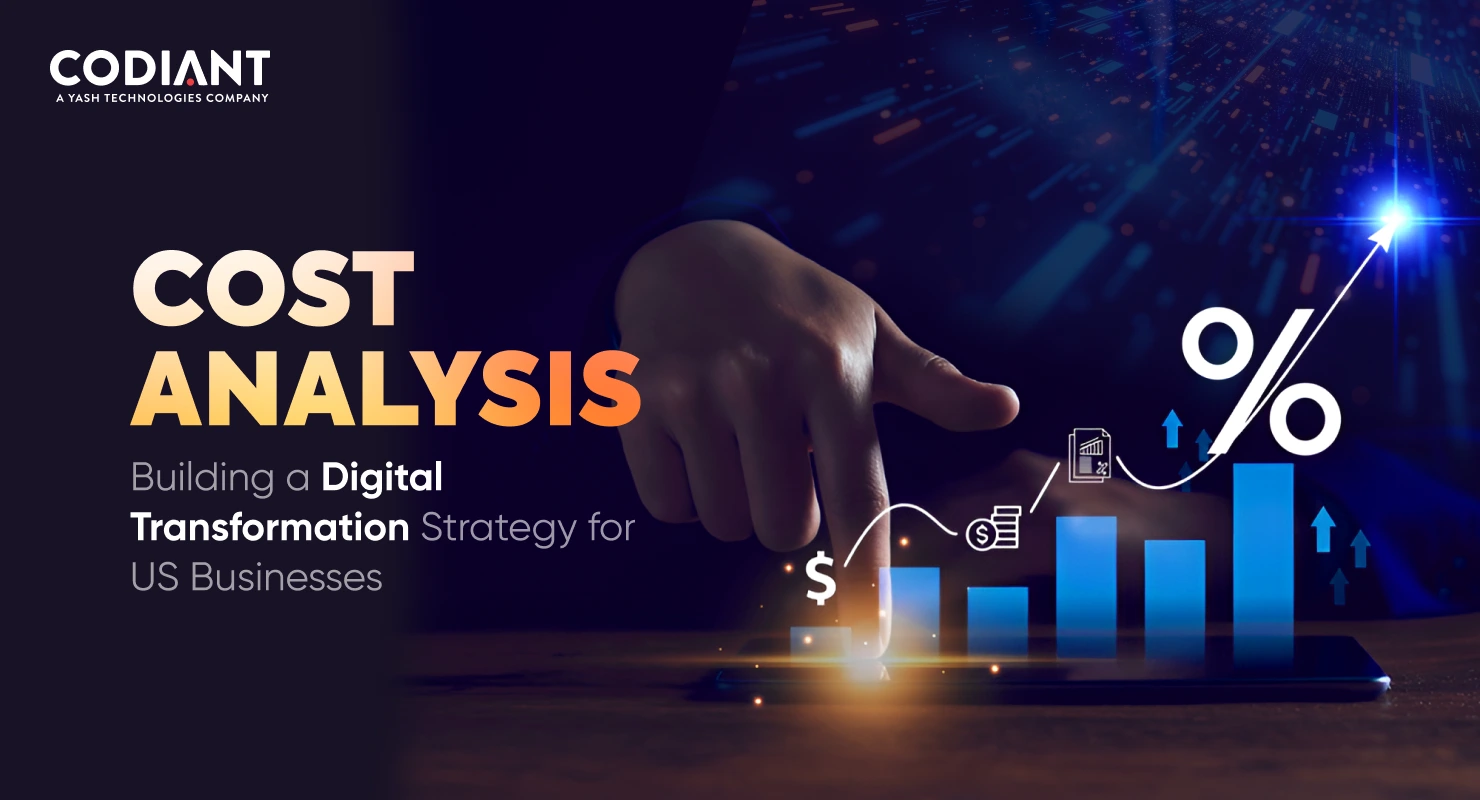
Digital transformation is not an option anymore – it’s a necessity for your business to succeed. Now, all organizations are refocusing on reinventing themselves by taking full advantage of advanced digital capabilities across the U.S. and the world. From fast-footed startups working up to the largest multinationals, companies are in a rush to achieve greater efficiency, generate higher returns, and accommodate a rapidly changing customer base. The goal is straightforward: Remain cautious, relevant and efficient.
But the truth is that the shift from antiquated legacy systems to digital-first, agile operations have become more critical than ever. And now, if you are one of the multitude of companies embracing this revolution, mind how much does it cost to have a successful digital transformation strategy? You’re not alone. Business leaders worldwide are asking themselves the exact same question as they strategy, budget, and execute within their organizations. It’s a big question, and the answer will have a big effect on the next chapter of your business.
Let’s break it down together, step by step, and explore the key factors that influence these costs, as well as how you can make the most of your investment.
Why a Digital Transformation Strategy Matters?
Before we parse dollars, let’s talk value.
A carefully developed digital transformation strategy is a roadmap for change, linking business outcomes with the required technologies, skills, and time frames. It helps answer:
- How will technology improve business performance?
- What legacy systems need replacing?
- Where can automation reduce cost and time?
- Which customer pain points should be solved digitally?
- How can we stay competitive in a rapidly shifting market?
Without a clear strategy, companies risk overspending on tools, underutilizing talent, and failing to realize ROI.
Your Transformation Journey Starts Now!
70% of companies are already driving transformation, and the results are speaking for themselves — they’re seeing 31% boost in revenue and saving 25% in operational costs.
Join them and take the next step toward success. We’re here to guide you through it.
Cost Expenses of Digital Transformation on Technologies & Services
The digital transformation tide is becoming stronger every once in a while. And, as market forecasts indicate, its adoption is making a huge leap forward as ever more companies come to understand the real value of it. What’s driving this shift? The answer is simple; businesses just want to work smarter, move faster and deliver better experiences to their customers.
Whether by minimizing the need for manual processes or uncovering important insights from real-time data, digital transformation is enabling businesses to operate more efficiently than ever. Digital transformation is not merely about playing catch-up — it’s about moving ahead. For companies that want to lead the charge on tech innovation, now is the time to invest in this shift.
Investing in digital now is an investment for a better tomorrow—with more-efficient processes, happier customers, and the agility to take on comes your way.
Talking about the figures, the digital transformation market is expected to reach $3.4 trillion by end of 2026.
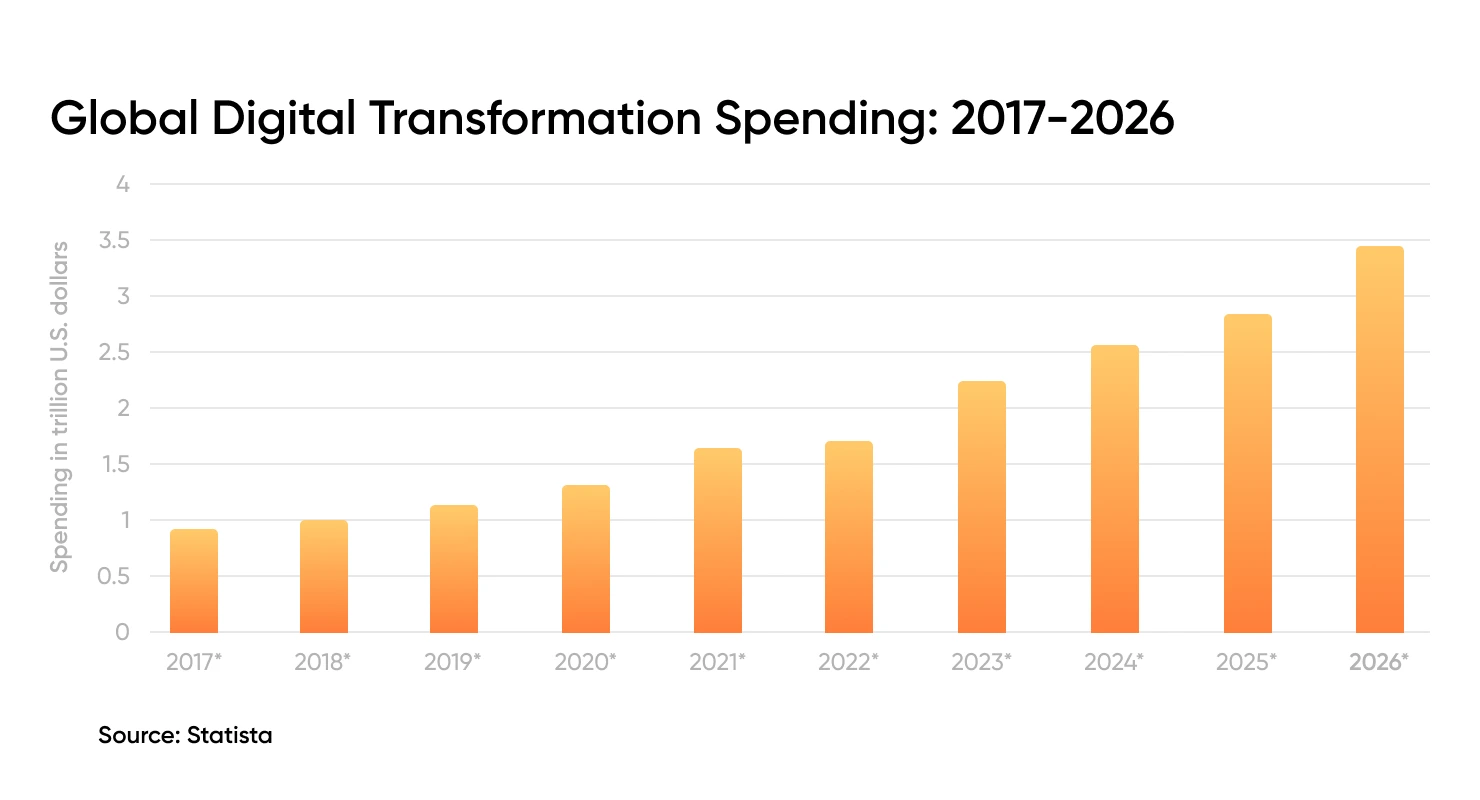
That’s a clear signal: now is the perfect time for businesses of all sizes to embrace change, modernize operations, and build smarter, more agile systems
Average Cost Range in the US
Depending on the size, complexity and nature of your business, the cost to build a digital transformation strategy in the U.S. is anywhere between $50,000 – $500,000 or more. This figure is for planning only, not the tools or infrastructure themselves. It might vary according to business requirements.
Many US businesses start with consultants to define the strategy, then build internal capability for execution, but what should you hire? A consultant? Or do it in-house?
| Criteria | In-House Team | Outsourced Team |
| Cost | Lower, but slow | Higher, faster execution |
| Expertise | Limited to current staff | Diverse, cross-industry insights |
| Bias | May preserve old habits | Brings outside perspective |
| Time to Strategy | 6–12 months | 3–6 months |
Key Cost Drivers Linked with Digital Transformation
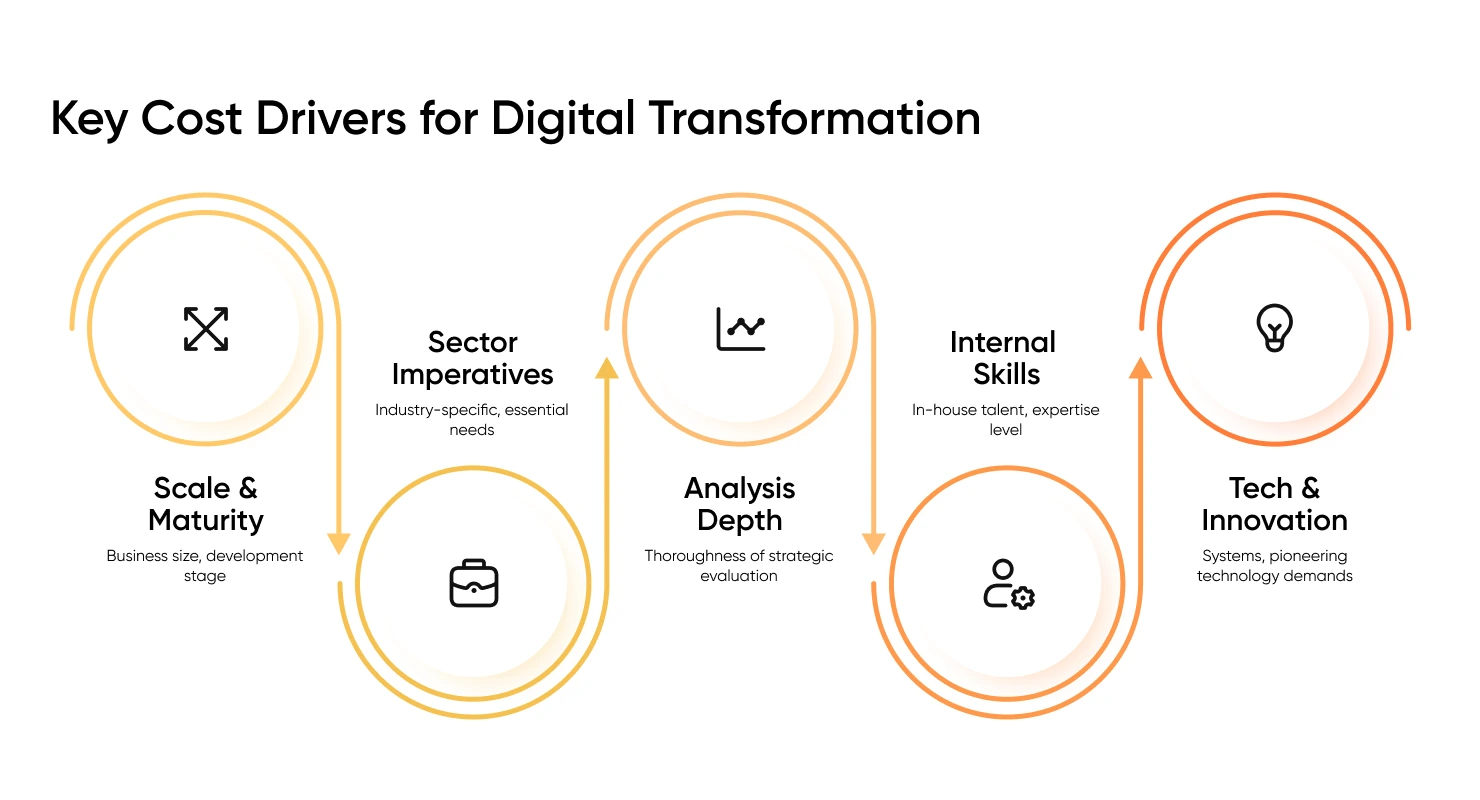
The cost can vary widely based on different factors. Here is the list of a few key cost drivers, have a look-
1. Business Size & Maturity
- Small Businesses (1–50 employees):
May require foundational digital assessments, costing between $25,000 to $75,000. - Midsize Businesses (50–500 employees):
Need more comprehensive strategy and IT alignment, averaging $100,000 to $200,000. - Enterprises (500+ employees):
With complex systems and global operations, strategy development can range from $250,000 to over $500,000.
2. Industry-Specific Needs
Sectors like healthcare, finance, and government have compliance-heavy requirements, driving up the cost. The more regulation and integration, the higher the cost. For example:
- A digital transformation strategy for a fintech firm may include risk modeling, fraud detection capabilities, and heavy data encryption.
- Healthcare providers need HIPAA-compliant systems and patient data strategies.
3. Depth of Analysis
Is it a light-touch strategy or a deep, end-to-end roadmap?
| Scope | What It Covers? | Cost Estimate |
| Basic | Market benchmarking, gap analysis, quick wins | $25K–$75K |
| Moderate | User journeys, process mapping, tool recommendations | $75K–$200K |
| Comprehensive | IT architecture, cloud roadmap, change management, data governance | $200K–$500K+ |
The more stakeholders and systems involved, the more in-depth the research—and cost.
4. Internal Capabilities
If your organization already has a dedicated digital team, you can cut down external consulting fees. But if you’re starting from scratch, you’ll need:
- Strategy consultants for accurate planning and direction.
- IT architects for infrastructure, systems, and technology alignment.
- UX designers for optimizing design work and user experience.
- Business analysts for data insights and process improvement.
- Change management experts for transition, adoption, and minimize disruption.
Hiring a digital transformation firm provides a cross-functional team, but comes at a higher cost than using internal talent.
5. Technology Stack & Innovation Needs
Do you just need a better CRM, or are you going all-in with AI, IoT, and edge computing? Right tech stack in your industry is essential to perform better technically. Innovative digital strategies that consider emerging tech, DevOps culture, and data platforms require special data-driven insights, which cost more.
What You are Paying in a Digital Transformation Strategy
Digital transformation is a structured business development plan that touches every aspect of your organization. Here’s a comprehensive breakdown of what’s the price tag actually covers and what you’re actually paying for.
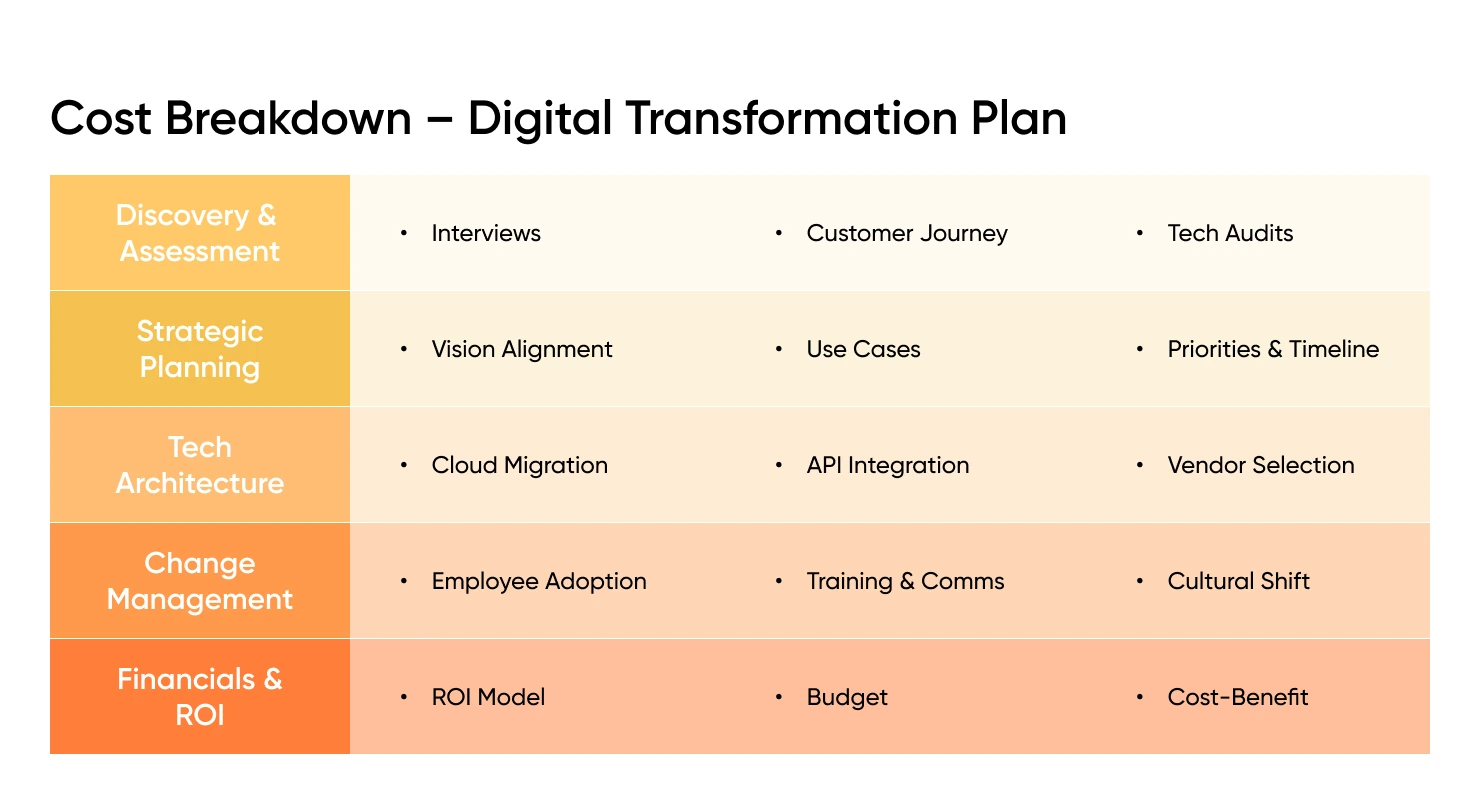
1. Business Discovery & Assessment
This initial phase focuses on gaining a deep understanding of your organization’s current landscape. It includes:
- Stakeholder Interviews: One-on-one sessions with executives and department leaders to identify pain points, goals, and alignment gaps, and define KPIs.
- Customer Journey Analysis: Mapping every touchpoint across your customer lifecycle to identify friction areas and opportunities for digital enhancement.
- Technology Audits: Reviewing existing tools, platforms, and software to assess compatibility, efficiency, and scalability.
2. Strategic Planning & Roadmapping
This phase translates business goals into a focused, actionable transformation plan. It includes:
- Vision & Mission Alignment: Ensuring digital goals are in sync with the company’s long-term direction.
- Use Case Identification: Highlighting high-impact digital use cases across departments to drive value early.
- Key Priorities & Timelines: Structuring a phased roadmap with clearly defined milestones and realistic timelines.
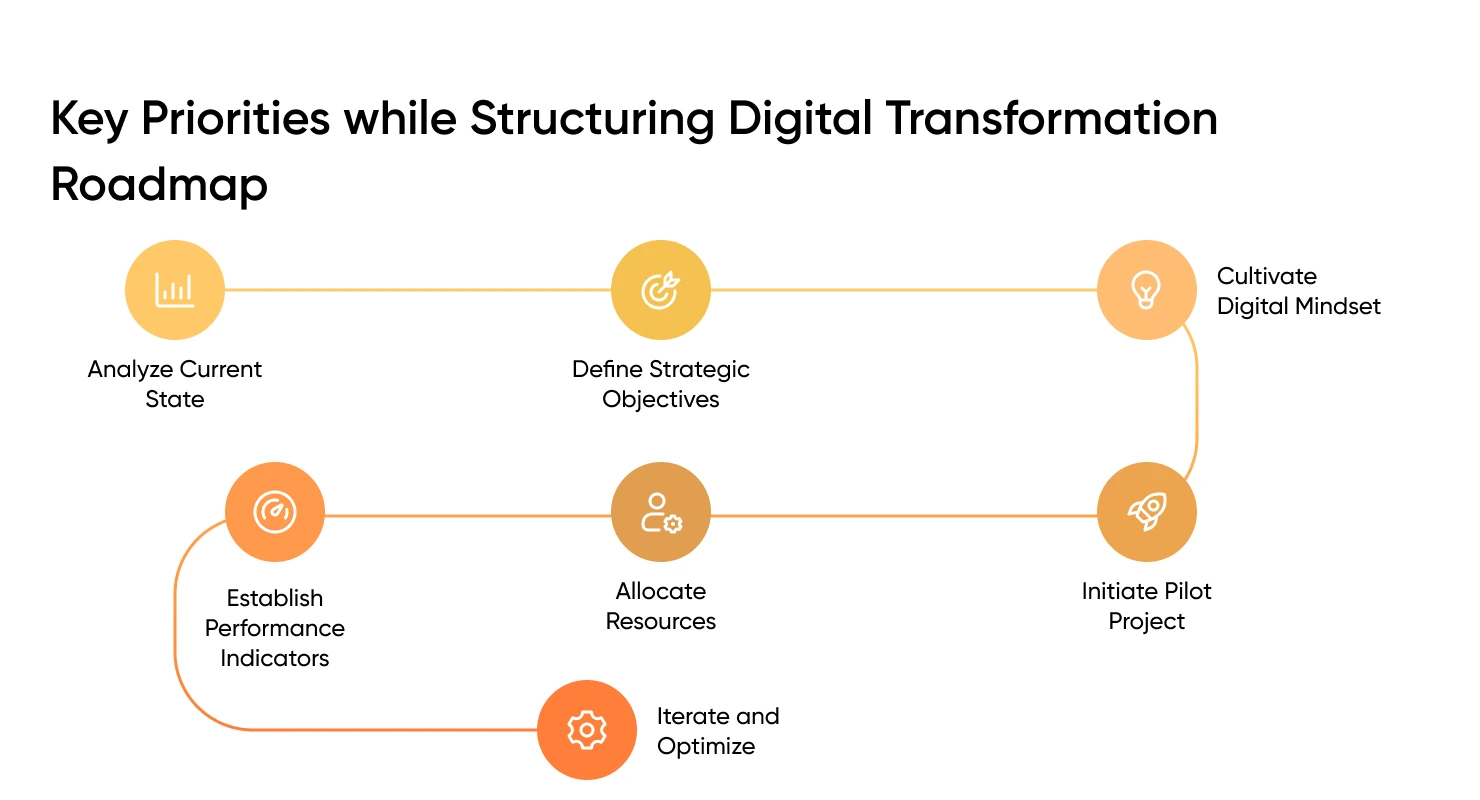
3. Technology Architecture & Recommendations
This section outlines the optimal technology infrastructure for scalable growth and reduce overall costs. It includes:
- Cloud Migration Strategy: Crafting a migration plan to shift on-premise systems to scalable, secure cloud platforms.
- API Integrations: Building seamless interoperability between new and existing platforms for smoother workflows.
- Vendor Selection Guidance: Recommending the automation and team management tools based on cost, features, and long-term needs.
4. Change Management Strategy
Transformation only works if your people are ready for it. This part focuses on organizational alignment through:
- Employee Adoption Roadmap: A step-by-step guide to encourage user adoption and reduce resistance to change.
- Training & Communication Plans: Structured training sessions and internal messaging strategies to build confidence and engagement.
- Cultural Shift Models: Developing leadership strategies and incentives to nurture a digital-first mindset across teams.
5. Financial Modeling & ROI Forecasting
A detailed financial plan backs every strategic recommendation. This includes:
- ROI Modeling: Estimating tangible outcomes such as cost savings, revenue growth, or efficiency gains over time.
- Budget Planning: Laying out projected costs for technology, resources, training, and implementation phases.
- Cost-Benefit Analysis: Comparing the anticipated benefits of transformation against total investment to justify spend and prioritize initiatives.
Boost Productivity, Streamline Workflows, and Unlock Great Cost Savings with Right Strategy!
At Codiant, we create digital strategies tailored to your unique business size, industry, and business objectives.
How to Keep Costs Under Control?
- Start with a pilot department: Don’t try to transform everything at once.
- Use existing platforms when possible: Don’t reinvent the wheel.
- Choose the right partner: Avoid over-engineered plans that never get executed.
- Measure success early: Define KPIs before you start.
Real-World Use Cases of Digital Transformation and Cost Management
Digital transformation is delivering real ROI across industries—not just by modernizing operations but also by significantly cutting costs. Here’s how various sectors are leveraging tech to streamline expenses and boost performance:
1. Retail
Retailers are adopting eCommerce platforms, AI-based product recommendations, and intelligent inventory management systems to enhance efficiency. AI also facilitates analyzing shopper behavior and making product recommendations to grow the average cart size and conversion rates. At the same time, real-time analytics-driven inventory management systems prevent overstocking and stockouts — and slash warehousing and logistics costs.
Some of the world’s most reputable brands, such as Walmart and Sephora, have been armed with greater supply chain agility and tailored shopping experiences, and have witnessed an increase in revenue and operational agility.
2. Healthcare
Hospitals and clinics are adopting telemedicine, electronic health records (EHR) and AI-driven diagnostics. These automations lower the administrative burden and eliminate repetitive paperwork while reducing patient wait times. Healthcare providers are able to save costs on administration through digitalizing patient records and consultations, while also increasing access to care and diagnostic accuracy.
Teledocto is an interoperable telehealth software that maximizes patient scheduling while minimizing cost to operate for the health systems.
3. Finance and Banking
Banks already use the blockchain for secure, consistently executed transactions without the need for intermediaries, which can now be achieved at a lower cost. Moreover, AI and machine learning programs are being used to pinpoint fraud in real time, cutting down on the number of fraud detection staff needed to identify and minimizing potential losses from illicit behaviour. JPMorgan Chase — banks are using Artificial Intelligence technology and other smart tools in mobile banking apps to automate repetitive tasks, reduce expenses and provide customers with faster and safer services.
4. Logistics and Supply Chain
In logistics, real-time tracking of product delivery is quite essential. It involves AI-driven route optimization and predicting inventory levels with analytics. The latest technologies and fully automated tools also help to decrease fuel usage, improve driver routes and avoid delays.
Today, Amazon and FedEx use real-time data to smooth the flow of deliveries and enhance warehouse operations, saving huge amounts on logistics and labor expenses.
5. Education
Educational institutions are utilizing online learning platforms, educational apps and virtual classrooms, drastically decreasing the need for physical infrastructure. This shift enables global access to quality education at a fraction of the traditional cost. Universities and ed-tech firms like Coursera are proving that digital-first models can deliver scalability and cost savings simultaneously.
How Codiant Can Accelerate Your Digital Transformation Journey
Codiant is a leading Mobile App Development Company in USA & digital transformation company that not just offer digital tools—but offer strategic consulting to align transformation initiatives with your core business objectives. Whether you’re a startup or an enterprise, we design tailored roadmaps are for scalability and making sure smooth adoption across all levels of your organization.
Our AI-powered solutions and automation tools help streamline operations, eliminate redundancies, and drive efficiency—translating directly to cost savings. From cloud migration and system integration to real-time analytics and intelligent dashboards, we build solutions that help in enhancing customer experiences.
Read more: How AI Is Used in the Restaurant Industry?
Key Takeaways
- The cost to develop a digital transformation strategy in US ranges from $50,000 to $500,000+, based on business size, scope, and complexity.
- A good strategy covers tech planning, process optimization, team alignment, and change readiness.
- The investment often pays for itself through increased efficiency, better CX, and higher profitability.
Frequently Asked Questions
It depends on how big your business is, how many systems you use, and how much change you want to make. The more complex things are, the more planning it takes.
It usually starts with a clear plan, but it doesn’t end there. As your business grows or changes, the strategy may need updates and support to stay useful.
This covers your current setup, points out what’s not working, suggests better tools or systems, and maps out how to make the changes step by step.
Building a strategy takes a few weeks to a few months, depending on how complex your business is and how many people or systems are involved.
Codiant works closely with you to understand your business goals. We then build a practical, easy-to-follow strategy that fits your needs and helps you grow faster with the right tech.
Featured Blogs
Read our thoughts and insights on the latest tech and business trends
How to Enable AI for Smart Diet Planning and Client Progress Tracking
- November 26, 2025
- Artificial Intelligence
Smart diet planning and consistent progress tracking have become essential in a world where people want faster, more accurate ways to manage their health. Traditional methods like manual calorie counting or generic meal charts often... Read more
How to Digitize Your Home-Service Business with an AI-Powered Platform
- November 21, 2025
- Home Services
The home-service industry - covering HVAC, plumbing, electrical, and cleaning—has long relied on manual scheduling, phone-based bookings, and paper invoices. But as customer expectations shift toward instant communication and transparency, these traditional processes are no... Read more
How a Voice AI Agent Can Help You Get More Appointments and Leads
- November 17, 2025
- Artificial Intelligence
Missed calls, delayed responses, and lost leads are silent revenue killers for many businesses. In today’s fast-moving market, customers expect instant engagement - and that’s exactly where a voice AI agent for appointment booking steps... Read more



